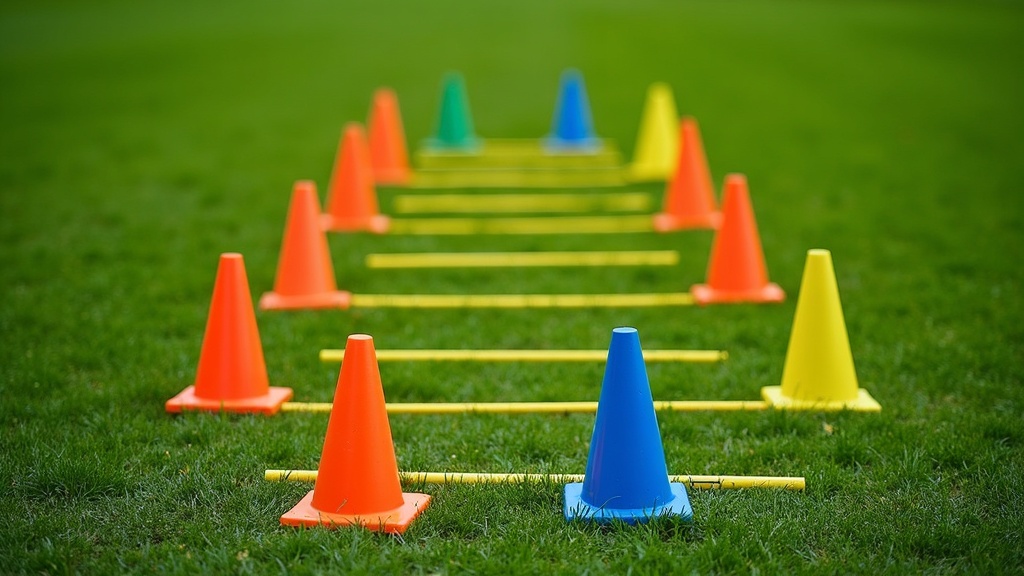Footwork and agility make a huge difference in just about every sport I’ve played or coached. If you’ve been struggling with slow movement, balance problems, or awkward changes in direction, you probably already know how much they can hold back performance. Thankfully, agility drill courses offer a pretty effective way to get those feet moving sharper and fix those nagging footwork and agility flaws. Here’s my full guide on common footwork issues, why they matter, and how agility courses can help any athlete become quicker, more balanced, and less injury-prone.

Common Footwork and Agility Problems
Even experienced athletes can end up with bad habits. Weak or uncoordinated footwork usually leads to missed plays, lost speed, and sometimes even avoidable injuries. Here are a few issues I see most often:
- Poor Balance: Losing your footing when making a quick cut or slowing down poorly can really throw off your whole game.
- Slow Change of Direction: If it takes too long to switch from forward to sideways or backwards, opponents can take advantage quickly.
- Heavy Feet: Stomping instead of moving light and springy makes it tough to react fast and conserve energy.
- Crossing Feet Incorrectly: Sometimes people cross their legs during shuffles instead of keeping them apart, which throws off stability.
- Predictable Movement Patterns: Repeating the same direction or speed makes it easy for others to read and counter your moves.
- Lack of Coordination: Moving arms and legs out of sync leads to awkward or unbalanced movement, especially during quick transitions.
Fixing these problems isn’t just about looking good on the field. It’s about moving with control, reacting quickly, and staying one step ahead. Recognizing these flaws is the first step toward correcting them and performing at your best.
How Agility Drill Courses Can Help
Agility training isn’t complicated, but it does need to be specific and consistent. I use courses made up of ladders, cones, hurdles, and markers (like disc cones or even towels). Agility courses challenge you to move in different directions, speeds, and rhythms. They teach the brain and body to work together, which helps you move more efficiently. This is important for both beginners and advanced players.
The main goals of agility courses are simple and effective:
- Improve reaction times and decision making
- Sharpen foot placement and timing
- Build balance and core stability
- Develop muscle memory for quick cuts and turns
- Boost overall coordination
When drills consistently target these specific goals, results come faster and last longer. Agility courses help athletes prepare for unpredictable moments in sports and real life.
Top Agility Drills for Better Footwork
Some drills are easy to set up at home or the gym, but what really matters is good form and gradually increasing speed. Here are a few drill ideas that have worked for me and for players I’ve coached:
- Ladder Drills: The classic agility ladder is great for teaching rapid foot movement. Basic in-and-out runs, side shuffles, and hopscotch patterns challenge both balance and pace.
- Shuttle Runs: Set two cones 10 to 20 meters apart. Sprint to one, touch the ground, sprint back, and repeat. This builds explosive power and sharper changes of direction.
- Figure 8s: Place two cones a few meters apart and run a figure eight pattern around them, focusing on quick pivots and staying low.
- Zigzag Cone Drills: Line up five cones in a zigzag and sprint through while weaving around them. This helps break the habit of predictable, straightline movement.
- Lateral Bounds: Jump sideways from left to right, landing on one foot and holding balance for a second before jumping back. Builds stability and foot control.
- Mirror Drills: Work with a partner. As they move left, right, forward, or back, you mirror their movement. This forces quick reaction and better coordination.
For those looking for readymade drills with more structure, I recommend checking out this agility and soccer drills resource. Their plans give you stepbystep routines you can use right away, making it way easier to get started or add some variety to your sessions. Sticking to a plan also helps track progress over time.
Setting Up Your Own Agility Course
You don’t need to break the bank to set up a quality agility course. A few cones, a basic ladder, and even chalk or sticks will do the trick. Here’s how I usually set one up:
- Spread out cones or markers in a pattern that mixes straight runs, curves, direction changes, and short sprints.
- Start easy, focusing on moving correctly instead of fast. Only speed up once your steps feel smooth and balanced.
- Add a few ladder drills at the start or finish to sharpen up quick feet.
- Switch up patterns every few sessions to keep the brain challenged and to avoid predictability.
Space doesn’t need to be a barrier. You can set up a compact course in a driveway, garage, gym, or park. For extra motivation, I like timing myself or others, then competing for the best improvement. If possible, get a few friends involved – a friendly competition fires up everyone and makes time fly.
Building Agility and Footwork Into Daily Training
Consistency matters way more than duration. Five to ten minutes of focused agility drills every few days can make a noticeable change in how you move and compete. I usually fit them in during warmups or right after stretching. Here’s what’s worked for me:
- Start every practice session with a couple ladder or cone drills to warm up the feet and brain.
- Mix up course layouts every week – try different angles, lengths, or obstacles for added challenge.
- Focus on posture: keep hips low, head up, and chest forward to maximize balance and speed.
- Emphasize quality over speed. Crisp, controlled movement beats racing through with sloppy steps.
Integrating agility work into your regular schedule keeps training fresh and staves off burnout. Even nonathletes can benefit by slipping in fun footwork games during family activities or friendly gatherings.
Common Mistakes to Watch For
Agility courses are great, but only if you’re mindful about your technique. A few mistakes I keep an eye out for include:
- Looking Down Too Much: Glancing at your feet the entire time leads to hunched posture and slow reaction. Try to keep your head up.
- Sloppy Foot Placement: Flailing limbs or letting the knees cave in increases injury risk. Train your feet to land softly, knees over toes.
- Speed Over Control: Rushing through drills usually means bad habits stick. Slow down until every step feels right, then dial up the pace.
- Forgetting the Arms: Arm swing plays a big role in overall quickness and balance. Let them move naturally with the legs.
If you’re new to this kind of training, recording yourself can help. Watching playback makes it easier to spot awkward form or slow reactions you might not notice in the moment. Selfawareness speeds up improvement and builds confidence as you see progress.
Benefits of Agility Drill Courses Beyond Sports
Agility and good footwork aren’t just about winning games. They help with everyday movement, lowering the chances of rolling an ankle stepping off a curb or making it easier to handle an unexpected slip or trip. Younger athletes build better motor skills for life, and older adults use agility drills to stay sharp and steady as they age. Plus, these drills are fun and motivating – so I rarely hear anyone complain about them during training. Agility can even help improve mental quickness and boost problem-solving under stress.
Getting Kids and Beginners Engaged
Younger players or those just getting into fitness can lose interest quickly with complicated or repetitive drills. Here are a few things I do to keep things fresh and rewarding:
- Use brightly colored cones and ladders to make drills more inviting
- Set up obstacle courses with friendly challenges or games (“race to the end!” or “beat your best time!”)
- Give lots of positive feedback for effort and improvement, not just for perfect form
- Mix in sportsspecific tasks, like dribbling a ball while running the course if they play soccer
If you’re looking for stepbystep soccer-specific agility drills for kids or beginners, the Soccer Tutor Online Soccer eAcademy has drill sets and videos I think are super useful for coaches and parents. These resources break things down into simple instructions and make learning way less intimidating.
Frequently Asked Questions About Agility Drill Courses
What’s the best equipment for at-home agility training?
Start with a basic agility ladder, a handful of cones, and a flat surface. You can get creative by marking spots on the ground with tape, chalk, or even plastic plates if cones aren’t around. Safe shoes and comfortable clothing round out your basic setup.
How many times per week should I do agility drills?
Shoot for 2 to 3 times a week, especially during the offseason. Just a few minutes each session is enough to see improvements, as long as you’re consistent and focused. Listen to your body and add extra sessions gradually if you enjoy it.
At what age should athletes begin agility training?
Kids as young as five or six can benefit from fun, simple agility and coordination games. Just keep drills age-appropriate and playful. For teenagers and adults, adding complexity helps keep things interesting and challenging.
How soon can I expect to see improvements?
With regular practice, you’ll probably notice lighter, crisper footwork in about two to four weeks. Every person progresses at their own pace, but small gains show up fast if you stick to it.
Real-World Impact: Stories From Training
I’ve watched young soccer players go from clumsy, tripping over their own feet to moving confidently and outmaneuvering opponents, all from sticking to simple drill routines. I remember working with a local youth team where a few kids dreaded agility drills at first, but after a month, they were actually battling to lead the warmup courses. Confidence grew as they saw themselves getting better, and soon it paid off in real match situations. That’s the kind of experience that makes the effort completely worthwhile.
Improving footwork and agility is pretty straightforward when you use structured, engaging drills and stay consistent. Small tweaks and fun routines can make a big change, both in athletic performance and everyday confidence. If you’re serious about stepping up your game or just want to feel lighter on your feet, putting together a simple agility course is a really smart step. For those who want more ideas, soccer and agility drill libraries like the Soccer Tutor Online Soccer Academy offer a ton of routines for every level. Whether you’re new or experienced, making agility work a habit will help you move better for a lifetime.
